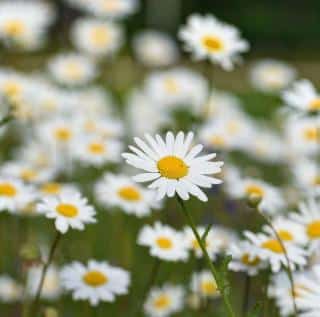

Savoring the garden without spending hours mowing or weeding it is the unfulfilled Quest of all gardeners. Though we dream about it all the time, reality must be acknowledged: the perfect zero-maintenance garden doesn’t exist.
The plant kingdom lives, dies, and is born again year after year, and coordinating that takes a little effort. Nonetheless, there are a few techniques and tips to let you relax in your garden without spending hours tending it.
The first thing that comes to mind when you visualize a garden is, simply, a lawn… and the mowing that goes along! In dry weather, you can space the mowing 2 or even 3 weeks apart. But if the weather alternates rain and sun, you’re going to have to mow every week. Did you know there were a few secret tricks to reduce that workload?
Lawn seeds are often mixed together in store-bought packets. Some resist foot traffic, others drought, still others will do fine in the shade, etc. There are even some lawn types that are chosen specifically because they grow slowly. So when you’re purchasing lawn seed, try to find packs that include several different species such as:
You can also aim form much more original solutions.

For a long time, these were really much too expensive, but nowadays some entry-line designs are available at reasonable prices, similar to how “normal” lawn mowers are priced. The technology keeps getting smarter and smarter, and now simple programs will save you hours of chores mowing.
Pruning, pinching tips, cutting back clumps, raking dead leaves… there’s always work to do in the garden whenever plants are present. Luckily, if you choose the right species and plant varieties, you can greatly reduce the gardening work overall.
There is a great many types of perennials (deciduous and evergreen) that won’t need care very often. These add color to the garden without costing you any labor: Ophiopogon, bear’s ears, saxifrage, hosta, heuchera, iris, etc.
These are certainly the best plants for a garden with no maintenance. Indeed, once planted, the only thing they need to stay under control is to cut them back at the beginning of spring. Careful though, because some species such as Stipa tenuifolia tend to self-sow on their own… uncontrollably! So it’s often wiser to select other grasses like blue fescue, Carex hachijoensis, Pennisetum, etc.
When chosen with care so that their location matches the exposure they require and enough space is available for them to grow, shrubs definitely have a spot in a zero-maintenance garden. However, to do away with the traditional fall chore of raking leaves, plant evergreen species instead of deciduous shrubs.
Whether you chose plant mulch (pine bark, flax, coconut fiber…) or mineral mulch (clay pebbles, slate, gravel, etc.), it’s always a good idea to spread mulch around the plants in your flower beds and along edges. It’s actually a key tip to reduce work in the garden. Not only will mulch make weeding a thing of the past (well, nearly so), it will also greatly reduce the need to water because it locks moisture in the soil.
In addition, as it breaks down, plant-based mulch will feed the soil with organic matter and nutrients. Plants growing in your shrub or flower bed can use this natural fertilizer to grow.
Smart tip: To really be effective, the layer of mulch should be at least 1 to 2 inches (3 to 5 cm) thick.
With their dry garden concept, our friends in Japan have understood one key truth: you don’t need to have a lot of plants to get a beautiful garden. While using the same rules for creating a flower bed, it’s perfectly possible to set up a soothing and elegant mineral landscape.
On top of this, you can of course include touches of greenery with a few carefully selected plants. Cactus, for instance, are a great maintenance-free option.
If your goal is to set up a garden that requires almost no gardening, you now have all the tricks in hand to succeed! Feel free to share the achievements you’re proud of as a comment.